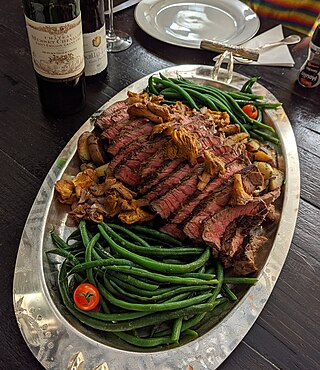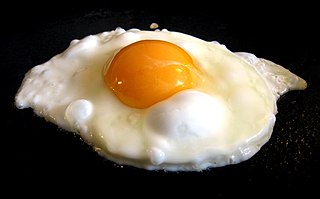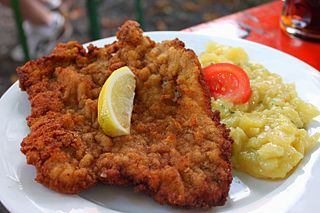
A beefsteak, often called just steak, is a flat cut of beef with parallel faces, usually cut perpendicular to the muscle fibers. In common restaurant service a single serving has a raw mass ranging from 120 to 600 grams. Beef steaks are usually grilled, pan-fried, or broiled. The more tender cuts from the loin and rib are cooked quickly, using dry heat, and served whole. Less tender cuts from the chuck or round are cooked with moist heat or are mechanically tenderized.

A fried egg is a cooked dish made from one or more eggs which are removed from their shells and placed into a frying pan and fried. They are traditionally eaten for breakfast in many countries but may also be served at other times of the day.

Latin American cuisine is the typical foods, beverages, and cooking styles common to many of the countries and cultures in Latin America. Latin America is a highly racially, ethnically, and geographically diverse with varying cuisines. Some items typical of Latin American cuisine include maize-based dishes arepas, empanadas, pupusas, tacos, tamales, tortillas and various salsas and other condiments. Sofrito, a culinary term that originally referred to a specific combination of sautéed or braised aromatics, exists in Latin American cuisine. It refers to a sauce of tomatoes, roasted bell peppers, garlic, onions and herbs. Rice, corn, pasta, bread, plantain, potato, yucca, and beans are also staples in Latin American cuisine.

Churrasco is the Portuguese and Spanish name for grilled beef prominent in the cuisines of Brazil, Uruguay, and Argentina. The term is used in other Spanish- and Portuguese-speaking countries for a variety of different meat products.

A schnitzel, colloquially known in Australian English as a schnitty, is a thin slice of meat. The meat is usually thinned by pounding with a meat tenderizer. Most commonly, the meat is breaded before frying. Breaded schnitzel is popular in many countries and is made using veal, pork, chicken, mutton, beef, or turkey. Schnitzel is very similar to the dish escalope in France and Spain, panado in Portugal, tonkatsu in Japan, cotoletta in Italy, kotlet schabowy in Poland, milanesa in Latin America, chuleta valluna in Colombia, chicken chop in Malaysia, and chicken-fried steak and pork tenderloin of the United States.

The milanesa is a variation of the Lombard veal Milanese, or the Austrian Wiener Schnitzel, where generic types of breaded cutlet preparations are known as a milanesa.
Peruvian cuisine reflects local practices and ingredients including influences mainly from the indigenous population, including the Inca, and cuisines brought by immigrants from Europe, Asia, and Africa. Without the familiar ingredients from their home countries, immigrants modified their traditional cuisines by using ingredients available in Peru.

Fried noodles are common throughout East Asia, Southeast Asia and South Asia. Many varieties, cooking styles, and ingredients exist.

Bife a cavalo, bife com ovo a cavalo, or bife a caballo is a traditional dish in Portugal, Brazil, and Argentina. It consists of a grilled, or sometimes pan-fried steak, with fried eggs on top. It is usually served with rice and beans and a salad. Its name literally means "horseback-riding steak", as an allusion to the appearance that the fried eggs are "riding" the steak. In Argentina, bife a caballo is usually served with French fries.

Chifa is Chinese Peruvian culinary tradition based on Cantonese elements fused with traditional Peruvian ingredients and traditions. The term is also used to refer to restaurants that serve the chifa cuisine.

Lomo saltado is a popular, traditional Peruvian dish, a stir fry that typically combines marinated strips of sirloin with onions, tomatoes, french fries, and other ingredients; and is typically served with rice. The dish originated as part of the chifa tradition, the Chinese cuisine of Peru, though its popularity has made it part of the mainstream culture.
The seco is a stew typical of Ecuadorian Cuisine. It can be made with any type of meat. According to an Ecuadorian popular etymology, the name of seco comes from the Península de Santa Elena in Ecuador, where at the beginning of the 20th century a camp English did oil work in Ancón, when referring to the second course of food, in English "second", the Ecuadorians repeated deforming the word until they reached the current "seco", which has been widely disseminated, despite being a myth, since records of this dish have been found since 1820, almost a century before the English presence in the Santa Elena Peninsula. At that time, deer and Creole goats abounded. According to the Dictionary of Peruvianisms of the Peruvian Wings University, seco is a «stew of beef, kid or another animal, macerated in vinegar, which is served accompanied by rice and a sauce of ají, huacatay and cilantro”. Thus, its main characteristic is to marinate and cook the chosen meat with some type of sauce acid, such as chicha, beer, naranjilla or vinegar.

Breaded cutlet or braised cutlet is a dish made from coating a cutlet of meat with breading or batter and either frying or baking it.

Steak and eggs is a dish of beefsteak and fried eggs in American cuisine and Vietnamese cuisine. It is most typically served as a breakfast or brunch food.

Chorrillana is a dish consisting of a plate of French fries topped with different types of sliced meat, sausages and other ingredients, most commonly scrambled or fried eggs, and fried onions.

The cuisine of Cape Verde is a West African cuisine largely influenced by Portuguese, Southern and Western European and West African cuisine. Cape Verde was a colony of Portugal from its colonization until 1975.














